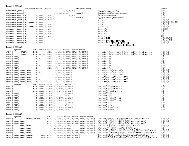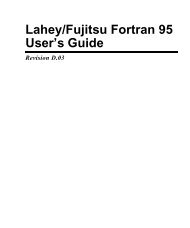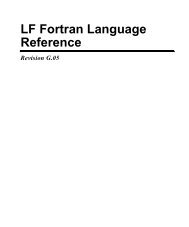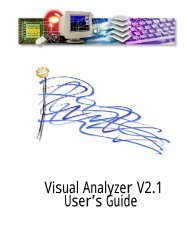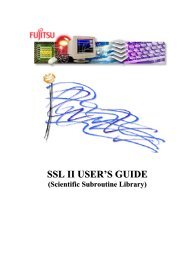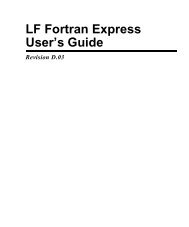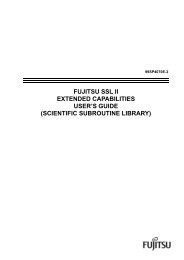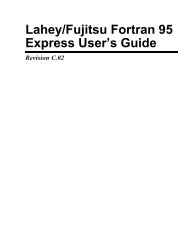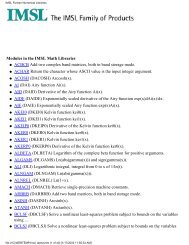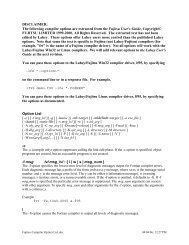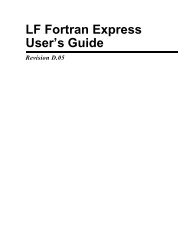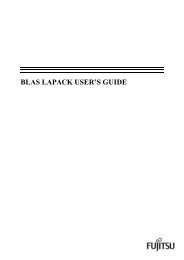- Page 1 and 2: SSL II USER’S GUIDE (Scientific S
- Page 3 and 4: This document contains technology r
- Page 6 and 7: CONTENTS SSL II SUBROUTINE LIST....
- Page 8: 11.3 Exponential Integral .........
- Page 11 and 12: Linear equations 2 Subroutine name
- Page 13 and 14: Eigenvalues 4 Subroutine name Item
- Page 15 and 16: Approximation 6 Subroutine name Ite
- Page 17 and 18: Numerical Quadrature 8 Subroutine n
- Page 19: J. Pseudo Random Numbers 10 Subrout
- Page 22 and 23: (as for the definition of them, see
- Page 24: PART I GENERAL DESCRIPTION
- Page 29 and 30: GENERAL DESCRIPTION 20 This alphanu
- Page 31 and 32: GENERAL DESCRIPTION Matrix definiti
- Page 33 and 34: GENERAL DESCRIPTION as shown below,
- Page 35 and 36: GENERAL DESCRIPTION ⎡ x1 ⎤ ⎢
- Page 37 and 38: CHAPTER 3 LINEAR ALGEBRA 3.1 OUTLIN
- Page 39 and 40: GENERAL DESCRIPTION • Determinant
- Page 41 and 42: GENERAL DESCRIPTION • Transpositi
- Page 43 and 44: GENERAL DESCRIPTION 34 rank (A) = r
- Page 45 and 46: GENERAL DESCRIPTION In addition, ob
- Page 47 and 48: GENERAL DESCRIPTION 38 routine, how
- Page 49 and 50: GENERAL DESCRIPTION 40 implicitly.
- Page 51 and 52: GENERAL DESCRIPTION where h is the
- Page 53 and 54: GENERAL DESCRIPTION 44 Table 4.7 Su
- Page 55 and 56: CHAPTER 5 NONLINEAR EQUATIONS 5.1 O
- Page 57 and 58: GENERAL DESCRIPTION 48 Table 5.3 No
- Page 59 and 60: GENERAL DESCRIPTION 50 * 1 * T * f
- Page 61 and 62: GENERAL DESCRIPTION Comments on use
- Page 63 and 64: GENERAL DESCRIPTION 54 (that is, at
- Page 65 and 66: GENERAL DESCRIPTION 56 is defined a
- Page 67 and 68: GENERAL DESCRIPTION 58 − Calculat
- Page 69 and 70: GENERAL DESCRIPTION 60 y y ( λ,
- Page 71 and 72: GENERAL DESCRIPTION 7.5 SERIES SSL
- Page 73 and 74: GENERAL DESCRIPTION 64 which defini
- Page 75 and 76:
GENERAL DESCRIPTION 8.6 LAPLACE TRA
- Page 77 and 78:
GENERAL DESCRIPTION Since G(s) is r
- Page 79 and 80:
GENERAL DESCRIPTION CHAPTER 9 NUMER
- Page 81 and 82:
GENERAL DESCRIPTION Table 9.2 Numer
- Page 83 and 84:
GENERAL DESCRIPTION and those combi
- Page 85 and 86:
GENERAL DESCRIPTION • Final value
- Page 87 and 88:
CHAPTER 11 SPECIAL FUNCTIONS 11.1 O
- Page 89 and 90:
GENERAL DESCRIPTION 11.8 BESSEL FUN
- Page 91 and 92:
GENERAL DESCRIPTION Table 12.2 Pseu
- Page 94 and 95:
A21-11-0101 AGGM, DAGGM Addition of
- Page 96 and 97:
value of Zl, l, |Dl| and − if |Dj
- Page 98 and 99:
E11-11-0101 AKLAG, DAKLAG Aitken-La
- Page 100 and 101:
E11-42-0101 AKMID, DAKMID Two-dimen
- Page 102 and 103:
p q p q f 0 1 1 2 () t = 1 − 3t 2
- Page 104 and 105:
E12-21-0201 AKMIN, DAKMIN Quasi-Her
- Page 106 and 107:
y−1 y0 y1 x−1 x0 x1 x2 x3 Fig.
- Page 108 and 109:
C **EXAMPLE** DIMENSION A(100,100),
- Page 110 and 111:
This purpose is sometimes obstructe
- Page 112 and 113:
By regarding this as a system of li
- Page 114 and 115:
Therefore, if the following holds,
- Page 116 and 117:
NMIN ≤ Number of evaluations ≤
- Page 118 and 119:
holds takes the form. Thus, if the
- Page 120 and 121:
example NMAX=2, NMAX is automatical
- Page 122 and 123:
Comments on use • Subprograms use
- Page 124 and 125:
G24-13-0101 AQMC8, DAQMC8 Multiple
- Page 126 and 127:
CALL AQMC8(M,LSUB,FUN,EPSA,EPSR, *N
- Page 128 and 129:
I = α + α 1 1∫−1 ∫ 1 1 −1
- Page 130 and 131:
G24-13-0201 AQME, DAQME Multiple in
- Page 132 and 133:
• Notes The function subprogram a
- Page 134 and 135:
• Computing procedure Procedure 1
- Page 136 and 137:
NMIN≤Number of evaluations≤NMAX
- Page 138 and 139:
much more accurate than required. I
- Page 140 and 141:
A21-12-0101 ASSM, DASSM Addition of
- Page 142 and 143:
perform singular value decompositio
- Page 144 and 145:
The first rotating angle φ 2, that
- Page 146 and 147:
500 FORMAT(2I5) 510 FORMAT(4E15.7)
- Page 148 and 149:
Table BICD1-1 Condition codes Code
- Page 150 and 151:
E12-32-3302 BICD3, DBICD3 B-spline
- Page 152 and 153:
E12-31-0102 BIC1, DBIC1 B-spline in
- Page 154 and 155:
E12-31-0202 BIC2, DBIC2 B-spline in
- Page 156 and 157:
E12-31-0302 BIC3, DBIC3 B-spline in
- Page 158 and 159:
E12-31-0402 BIC4, DBIC4 B-spline in
- Page 160 and 161:
E11-32-1101 BIFD1, DBIFD1 B-spline
- Page 162 and 163:
WRITE(6,650) IXX,IYY,((R(I,J),I=1,5
- Page 164 and 165:
Table BIFD3-1 Condition codes Code
- Page 166 and 167:
DO 40 L2=1,M2 ISW=L2-2 WRITE(6,620)
- Page 168 and 169:
DO 30 I=1,N1 H=(X(I+1)-X(I))/5.0 XI
- Page 170 and 171:
DO 20 J=1,6 V=XI+H*FLOAT(J-1) II=I
- Page 172 and 173:
DO 30 I=1,N1 H=(X(I+1)-X(I))/5.0 XI
- Page 174 and 175:
The value of In(x) is computed as a
- Page 176 and 177:
I11-81-0601 BI0,DBI0 Zero order mod
- Page 178 and 179:
I11-81-1001 BJN, DBJN Integer order
- Page 180 and 181:
I11-83-0101 BJR, DBJR Real order Be
- Page 182 and 183:
I11-81-0201 BJ0,DBJ0 Zero order Bes
- Page 184 and 185:
I11-81-0301 BJ1, DBJ1 First order B
- Page 186 and 187:
I11-81-1301 BKN, DBKN Integer order
- Page 188 and 189:
I v () x ⎧ v ⎪ ⎛ x ⎞ ⎪ 1
- Page 190 and 191:
Equation (4.29) can be expressed us
- Page 192 and 193:
I11-81-0901 BK1, DBK1 First order m
- Page 194 and 195:
=(aij (s) ), balancing is performed
- Page 196 and 197:
for the constant vector). However,
- Page 198 and 199:
A52-11-0202 BLU1, DBLU1 LU-decompos
- Page 200 and 201:
where ⎡1 ⎤ ⎢ ⎥ ⎢ 1 0 ⎥
- Page 202 and 203:
• Example Simultaneous linear equ
- Page 204 and 205:
where ( x y )( ) s1= n + n + 2m m+
- Page 206 and 207:
Replacing the updated knots in the
- Page 208 and 209:
For the matrix (T−λ I) shown in
- Page 210 and 211:
E32-31-0102 BSC1, DBSC1 B-spline sm
- Page 212 and 213:
E32-31-0202 BSC2, DBSC2 B-spline sm
- Page 214 and 215:
may assume the minimum. (For detail
- Page 216 and 217:
C **EXAMPLE** DIMENSION A(1100),E(1
- Page 218 and 219:
attained. If so, it is safe to choo
- Page 220 and 221:
Z T Z=P T C T ΛΛΛΛ 2 CP=LL T Wh
- Page 222 and 223:
Jennings' acceleration is effective
- Page 224 and 225:
obtained by subroutine BSCD2. There
- Page 226 and 227:
DO 10 I=1,N 10 W(I)=1.0 CALL BSC1 (
- Page 228 and 229:
Given µj as an approximation of λ
- Page 230 and 231:
B51-21-0302 BTRID, DBTRID Reduction
- Page 232 and 233:
I11-81-1101 BYN, DBYN Integer order
- Page 234 and 235:
J ⎛ 1 ⎜− + ⎝ 4 2! Γ 3 −
- Page 236 and 237:
a 0 l = 1 l a = i ⎪ 2 2 2 2 2 2 (
- Page 238 and 239:
Theoretical precision = 10.66 digit
- Page 240 and 241:
Q 1 1 = ∑ k 2 ∑ k= 0 k= 0 2k +
- Page 242 and 243:
I11-82-1301 CBJN, DCBJN Integer ord
- Page 244 and 245:
is repeatedly applied to k=m,m-1,..
- Page 246 and 247:
• For: Single precision: |Im(z)|
- Page 248 and 249:
B21-15-0202 CBLNC, DCBLNC Balancing
- Page 250 and 251:
I11-82-1401 CBYN, DCBYN Integer ord
- Page 252 and 253:
IF(MM.EQ.0) GO TO 50 DO 40 INT=1,MM
- Page 254 and 255:
I11-11-0201 CELI2, DCELI2 Complete
- Page 256 and 257:
F12-15-0101 CFT, DCFT Multi-variate
- Page 258 and 259:
In this routine, the 8 and 2 radix
- Page 260 and 261:
where definitions of K1, ..., KM, J
- Page 262 and 263:
= n 2 2 = r ⋅ q + q ⋅ r + ( q
- Page 264 and 265:
without permutation. So, by the del
- Page 266 and 267:
Method This subroutine performs dis
- Page 268 and 269:
F12-15-0302 CFTR, DCFTR Discrete co
- Page 270 and 271:
NT ( = N1× N2× N3) * One-dimensio
- Page 272 and 273:
A11-40-0101 CGSBM, DCGSBM Storage m
- Page 274 and 275:
Elements in the general mode Elemen
- Page 276 and 277:
DO 30 J=1,N IM=MIN0(J+1,N) DO 30 I=
- Page 278 and 279:
Method An n-order complex matrix A
- Page 280 and 281:
The process for the complex QR meth
- Page 282 and 283:
C **EXAMPLE** COMPLEX ZA(100,100),Z
- Page 284 and 285:
C22-15-0101 CJART, DCJART Zeros of
- Page 286 and 287:
A22-15-0202 CLU, DCLU LU-decomposit
- Page 288 and 289:
A22-15-0602 CLUIV, DCLUIV The inver
- Page 290 and 291:
A22-15-0302 CLUX, DCLUX A system of
- Page 292 and 293:
B21-15-0702 CNRML, DCNRML Normaliza
- Page 294 and 295:
I11-41-0201 COSI, DCOSI Cosine inte
- Page 296 and 297:
A11-40-0201 CSBGM, DCSBGM Storage m
- Page 298 and 299:
A11-50-0201 CSBSM, DCSBSM Storage m
- Page 300 and 301:
A11-50-0101 CSSBM, DCSSBM Storage c
- Page 302 and 303:
Method The subroutine uses Muller
- Page 304 and 305:
FUNCTION FUN(X) REAL*8 SUM,XP,TERM
- Page 306 and 307:
WRITE(6,611) X,P,Q 3 CONTINUE W=W+W
- Page 308 and 309:
Therefore if real part uj and imagi
- Page 310 and 311:
From matrix F thus obtained and tra
- Page 312 and 313:
601 FORMAT(/(5E15.5)) 610 FORMAT('0
- Page 314 and 315:
Theoretical precision = 10.04 digit
- Page 316 and 317:
trigonometric function values neces
- Page 318 and 319:
in the sense that it can be utilize
- Page 320 and 321:
Step 4: Discrete cosine transform (
- Page 322 and 323:
the maximum value of (power of 2) +
- Page 324 and 325:
Method This subroutine applies disc
- Page 326 and 327:
It also calculates norm f based on
- Page 328 and 329:
• Example By inputting n sample p
- Page 330 and 331:
F11-11-0101 FCOST, DFCOST Discrete
- Page 332 and 333:
The equations shown in (4.3) can be
- Page 334 and 335:
The degree of error decerement grea
- Page 336 and 337:
Method This subroutine applies disc
- Page 338 and 339:
terms is about nlog2 n. To save sto
- Page 340 and 341:
Even when the dimension differs, th
- Page 342 and 343:
F11-21-0101, FSINT, DFSINT Discrete
- Page 344 and 345:
B52-11-0101 GBSEG, DGBSEG Eigenvalu
- Page 346 and 347:
For detailed information about the
- Page 348 and 349:
E51-30-0301 GCHEB, DGCHEB Different
- Page 350 and 351:
A25-31-0101 GINV, DGINV Moore-Penro
- Page 352 and 353:
B22-10-0402 GSBK, DGSBK Back transf
- Page 354 and 355:
B22-21-0302 GSCHL, DGSCHL Reduction
- Page 356 and 357:
B22-21-0201 GSEG2, DGSEG2 Eigenvalu
- Page 358 and 359:
The above processing are accomplish
- Page 360 and 361:
Comments • Subprogram used SSL II
- Page 362 and 363:
In this case, the current stepsize
- Page 364 and 365:
For further information, refer to t
- Page 366 and 367:
WRITE(6,630) (J,J=INT,LST) WRITE(6,
- Page 368 and 369:
Method An n-order real matrix A is
- Page 370 and 371:
B21-11-0402 HSQR,DHSOR Eigenvalues
- Page 372 and 373:
B21-11-0502 HVEC,DHVEC Eigenvectors
- Page 374 and 375:
CALL HVEC(A,100,N,ER,EI,IND,M,EV,10
- Page 376 and 377:
E51-30-0401 ICHEB, DICHEB Indefinit
- Page 378 and 379:
I11-71-0301 IERF, DIERF Inverse err
- Page 380 and 381:
(c) 2.5 10 -3 ≤x
- Page 382 and 383:
I11-61-0201 IGAM2, DIGAM2 Incomplet
- Page 384 and 385:
I11-91-0301 INDF, DINDF Inverse nor
- Page 386 and 387:
E12-21-0101 INSPL, DINSPL Cubic spl
- Page 388 and 389:
F20-01-0101 LAPS1, DLAPS1 Inversion
- Page 390 and 391:
F20-02-0101 LAPS2, DLAPS2 Inversion
- Page 392 and 393:
F20-03-0101 LAPS3, DLAPS3 Inversion
- Page 394 and 395:
In each of the above, the delay fac
- Page 396 and 397:
This subroutine calculates f(t) for
- Page 398 and 399:
10 READ(5,510) (B(I),I=1,N) WRITE(6
- Page 400 and 401:
610 FORMAT(///10X,'CONSTANT VECTOR=
- Page 402 and 403:
A25-21-0101 LAXLM, DLAXLM Least squ
- Page 404 and 405:
Where ~ b is an n-dimensional vecto
- Page 406 and 407:
A25-11-0401 LAXLR, DLAXLR Iterative
- Page 408 and 409:
A22-11-0401 LAXR, DLAXR Iterative r
- Page 410 and 411:
esults, this indicates that the con
- Page 412 and 413:
• Example In this example, l syst
- Page 414 and 415:
Table LBX1R-1 Condition codes code
- Page 416 and 417:
A22-15-0101 LCX,DLCX A system of li
- Page 418 and 419:
A22-15-0401 LCXR,DLCXR Iterative re
- Page 420 and 421:
x (1) is e (1) (=x (1) − x), its
- Page 422 and 423:
Method Given the LDL T decomposed m
- Page 424 and 425:
Method To solve a system of linear
- Page 426 and 427:
500 FORMAT(I5) 510 FORMAT(2F10.0) 6
- Page 428 and 429:
C **EXAMPLE** EXTERNAL FUN A=-5.0 B
- Page 430 and 431:
e resumed by calling this subroutin
- Page 432 and 433:
C21-41-0101 LOWP, DLOWP Zeros of a
- Page 434 and 435:
D21-10-0101 LPRS1, DLPRS1 Linear pr
- Page 436 and 437:
(which is derived form other constr
- Page 438 and 439:
• Basic inveerse matrix B -1 for
- Page 440 and 441:
A52-21-0101 LSBIX, DLSBIX A system
- Page 442 and 443:
A52-31-0101 LSBX, DLSBX A system of
- Page 444 and 445:
A52-31-0401 LSBXR, DLSBXR Iterative
- Page 446 and 447:
• Accuracy estimation for approxi
- Page 448 and 449:
C **EXAMPLE** DIMENSION A(5050),B(1
- Page 450 and 451:
• Example An approximate solution
- Page 452 and 453:
This subroutine make use of the cha
- Page 454 and 455:
A22-51-0101 LSX, DLSX A system of l
- Page 456 and 457:
A22-51-0401 LSXR, DLSXR Iterative r
- Page 458 and 459:
A52-11-0501 LTX, DLTX A system of l
- Page 460 and 461:
( ) m k+ 1 ,k ( k ) ( k = a ) k+ 1,
- Page 462 and 463:
Method This subroutine computes the
- Page 464 and 465:
500 FORMAT(I5) 510 FORMAT(4E15.7) 6
- Page 466 and 467:
y n i =∑ j= 1 a ij x j , i = 1,..
- Page 468 and 469:
The subroutines PBM and PGM are use
- Page 470 and 471:
SUBROUTINE PCM(ICOM,L,ZA,K,M,N) DIM
- Page 472 and 473:
The subroutines PSM and PGM in this
- Page 474 and 475:
A21-11-0401 MGSM, DMGSM Multiplicat
- Page 476 and 477:
for the iteration vector xk and if
- Page 478 and 479:
• If 2α k < α min < 4α k , the
- Page 480 and 481:
Giving MAX: For a variable vector x
- Page 482 and 483:
ϕ (α) f 0 f 1 f 2 α k 2α k 4α
- Page 484 and 485:
Method The multiplication ( y ) is
- Page 486 and 487:
A21-12-0301 MSSM, DMSSM Multiplicat
- Page 488 and 489:
Method This subroutine performs mul
- Page 490 and 491:
I11-91-0201 NDFC, DNDFC Complementa
- Page 492 and 493:
Table NLPG1-1 Condition codes Code
- Page 494 and 495:
( x , λλλλ ) ∇ φ( x λλλλ
- Page 496 and 497:
C24-11-0101 NOLBR, DNOLBR Solution
- Page 498 and 499:
k T ( y) ≈ f ( y ) + g ( y − )
- Page 500 and 501:
value for an additional evaluation
- Page 502 and 503:
2) To compute the difference approx
- Page 504 and 505:
MAX The function evaluation count i
- Page 506 and 507:
m n 2 ∑∑( fi / x j ) / ( mn) v
- Page 508 and 509:
500 FORMAT(I5) 510 FORMAT(5E15.7) 6
- Page 510 and 511:
EPSA ..... Input. Absolute error to
- Page 512 and 513:
IF(ICON.EQ.30000) STOP GO TO 10 20
- Page 514 and 515:
c ( x − xm )( x − x−1 ) ... (
- Page 516 and 517:
− k > 2 and max (ERKM1, ERKM2)
- Page 518 and 519:
H11-20-0151 ODGE, DODGE A stiff sys
- Page 520 and 521:
Table ODGE-1 Condition codes Code M
- Page 522 and 523:
Method Both Gear’s and Adams meth
- Page 524 and 525:
xm+1 is determined, solution ye at
- Page 526 and 527:
8) Corrector iteration This subrout
- Page 528 and 529:
Table ODRK1-1 Condition codes Code
- Page 530 and 531:
h′ = + { 6 min hi hi fi ( x0, y0
- Page 532 and 533:
Thus, this subroutine is used with
- Page 534 and 535:
J12-20-0101 RANB2 Generation of bin
- Page 536 and 537:
J11-30-0101 RANE2 Generation of exp
- Page 538 and 539:
2) For u − 0 . 5 > 0. 46875 G -1
- Page 540 and 541:
J12-10-0101 RANP2 Generation of Poi
- Page 542 and 543:
J11-10-0101 RANU2 Generation of uni
- Page 544 and 545:
There is a theory that such a perio
- Page 546 and 547:
is coupled such as Pi (IXi, IXi+1)
- Page 548 and 549:
m = m1 + m2 + ... + ms One call of
- Page 550 and 551:
One call of this subroutine enables
- Page 552 and 553:
F11-31-0101 RFT, DRFT Discrete real
- Page 554 and 555:
from α α α x1 k x2 k x1 0 1 =
- Page 556 and 557:
faster than second order. • K pol
- Page 558 and 559:
Letting ( ) λ 2 ( ) σ ( x) = x +
- Page 560 and 561:
C **EXAMPLE** DIMENSION Y(3,10),F(3
- Page 562 and 563:
A52-31-0202 SBDL, DSBDL LDL T -deco
- Page 564 and 565:
A52-21-0202 SBMDM, DSBMDM MDM T dec
- Page 566 and 567:
1) Determines 2) If ( k − 1) ( k
- Page 568 and 569:
DO 10 I=1,N WRITE(6,630) I,(EV(I,J)
- Page 570 and 571:
eigenvectors are determined using t
- Page 572 and 573:
A21-11-0201 SGGM, DSGGM Subtraction
- Page 574 and 575:
G23-11-0101 SIMP2, DSIMP2 Integrati
- Page 576 and 577:
a ( 4, 2 ) ( 2, 1 ) ( 5, 2 ) ( 1, 0
- Page 578 and 579:
I11-41-0101 SINI, DSINI Sine integr
- Page 580 and 581:
C **EXAMPLE** DIMENSION A(5050) 10
- Page 582 and 583:
i.e., -s is stored in IP (k+1). The
- Page 584 and 585:
E31-11-0101 SMLE1, DSMLE1 Data smoo
- Page 586 and 587:
E31-21-0101 SMLE2, DSMLE2 Data smoo
- Page 588 and 589:
E11-21-0101 SPLV, DSPLV Cubic splin
- Page 590 and 591:
(c) (ISW(1) =3,DY (1)=, f"( x1)/f"(
- Page 592 and 593:
B21-21-0602 TEIG1, DTEIG1 Eigenvalu
- Page 594 and 595:
B21-21-0702 TEIG2, DTEIG2 Selected
- Page 596 and 597:
• Direct sum of submatrices If T
- Page 598 and 599:
B21-21-0802 TRBK, DTRBK Back transf
- Page 600 and 601:
B21-25-0402 TRBKH, DTRBKH Back tran
- Page 602 and 603:
B21-25-0302 TRIDH, DTRIDH Reduction
- Page 604 and 605:
where, l = n − k + 1 1 2 1 = k tl
- Page 606 and 607:
( ( ) ) ( ( ) ) ( ( ) ) 2 σ k k 2
- Page 608 and 609:
T= d 1 e 1 e 1 d 2 e 2 0 e 2 e n−
- Page 610 and 611:
C23-11-0111 TSDM, DTSDM Zero of a r
- Page 612 and 613:
• Convergence criteria The follow
- Page 614 and 615:
Variables a, b, and c have the foll
- Page 616 and 617:
APPENDIX A AUXILIARY SUBROUTINES A.
- Page 618 and 619:
A.3 MGSSL Printing of condition mes
- Page 620 and 621:
A.5 ASUM(BSUM), DSUM(DBSUM) Product
- Page 622 and 623:
A.7 IRADIX Radix of the floating-po
- Page 624 and 625:
APPENDIX B ALPHABETIC GUIDE FOR SUB
- Page 626 and 627:
TableB.1-conteimued Subroutine Clas
- Page 628 and 629:
B.3 AUXILIARY SUBROUTINES Table B.3
- Page 630 and 631:
Interpolation and approximation Cod
- Page 632 and 633:
[20] Brezinski, C. Acceleration de
- Page 634 and 635:
[82] Uno,T. Bessel Function. Baifuk
- Page 636 and 637:
Author Subroutine Item T. Torii ECH



